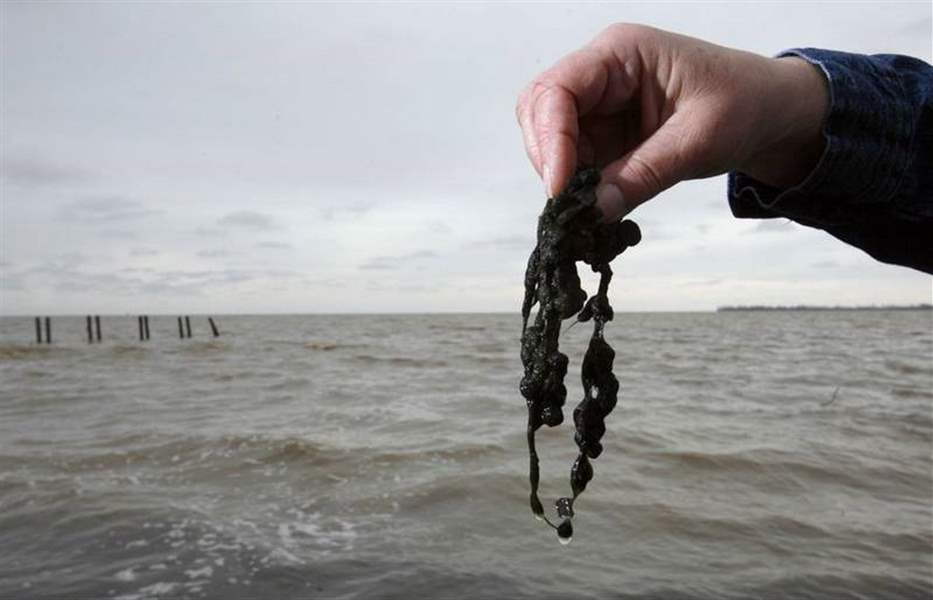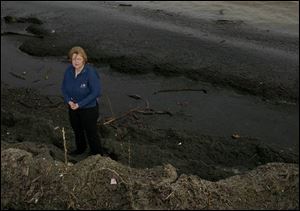
Questions arise over silt disposal in Maumee Bay
3/23/2008
Sandy Bihn holds 'Iyngbya wollei' algae, a toxic weed that clogs boat intakes and has knocked down a windsurfer.

Sandy Bihn stands in 'lyngbya wollei' algae along the shore near her Maumee Bay home. The noxious weed, she and others say, is fueled by the Army Corps of Engineers' open-lake disposal of dredged silt.
Millions of pounds of muck.
Like an annual rite of spring, the U.S. Army Corps of Engineers soon will spend about $4 million to have that dredged from the Toledo shipping channel again so Great Lakes cargo ships can ply the water without getting stuck.
The work will start in the channel's outer reaches in western Lake Erie's Maumee Bay. Then on June 15, weeks after the annual walleye run ends in late April, the dredges can move into Toledo's inner harbor to clear silt from the portion of the shipping channel that's in the Maumee River.
No getting around it. If the ships can't pass through, the local economy will suffer.
Past and current governors from Michigan and Ohio don't argue that point. Nor do their state environmental agency directors, plus a number of U.S. senators, university biologists, and environmental activists.
What they've all tried, to no avail, is to get the Corps to phase out its practice of dumping the majority of the dredged material out in Maumee Bay, 3 1/2 miles northwest of Toledo Harbor Light.
Open-lake disposal, as it's called, is controversial because it resuspends silt in the water column, making the water more turbid. Biologists long have questioned what that does to the region's multibillion-dollar fishing industry.
Now, there's a public health and property-value threat - a toxic algae called lyngbya wollei - drawing more attention to the issue.

Sandy Bihn holds 'Iyngbya wollei' algae, a toxic weed that clogs boat intakes and has knocked down a windsurfer.
At the March 13 Western Lake Erie Waterkeeper Association's conference in Toledo and Wednesday's Ohio Lake Erie Commission meeting in Oak Harbor, questions were raised about the degree by which resuspended sediment - presumably laden with fertilizers - might be helping the noxious weed grow.
Sandy Bihn, an Oregon activist who has gobs of the stuff clinging to the shoreline along her Maumee Bay property, said she's learned from researchers down South that the algae is a "cancer" that won't go away on its own.
She said there was enough last summer to knock down a windsurfer and clog boat intakes.
One expert she's consulted recently, Hans Paerl, a University of North Carolina marine and environmental sciences professor, said the algae - which is toxic if ingested - grows like cockroaches.
Lyngbya wollei has proven over two winters it can do something most other forms of algae can't: survive freezing Great Lakes temperatures.
Even now, with lake ice melting, it is thick enough to be observed from air, said Jon J. Gulch, an on-scene coordinator in the U.S. Environmental Protection Agency's emergency response branch.
Ohio EPA Director Chris Korleski admitted he doesn't know that much about the algae or the possible correlation between it and the Corps' dredging activity.
Scientists noted there could be other things helping it grow, such as the unexplained rise in phosphorus loading into the Maumee River since 1997 and the thermal impact of discharges from FirstEnergy Corp.'s coal-fired Bayshore power plant in Oregon.
Open-lake disposal - which has been scorned for a variety of other reasons - is not likely more than a contributor.
But has its time come?
Three Corps officials from the Buffalo district office, which oversees Ohio - Kathy Griffin, operations branch chief; Scott Pickard, ecologist, and Mike Asquith, dredging program manager - defended their agency's practice as one that meets the requirements of the federal Clean Water Act.
The Corps remains open to viable alternatives, should nonfederal match money become available, they said.
But like a lot of things, that's where the discussion ends: money.
If the Corps could get a budget increase of $2 million a year for the Toledo work, or $6 million total, plus another $1 million in nonfederal match money, it could build a diked-off site in the lake that holds dredged material while providing more valuable wildlife habitat. Such dual-purpose projects have their advantages, Ms. Griffin said.
The other option - a new land-based confined disposal facility - would cost a staggering $200 million in today's economy. Some 35 percent of that, or $70 million, would have to come from nonfederal sources, she said.
The Toledo area has two of those kind of dumps, but they're reserved exclusively for Toledo-area sediment that's too polluted to be put back into the water. That's about 10 percent of Toledo's total, the Corps said.
Cleveland is making plans to build a new confined disposal facility, even though it only does about 40 percent of the dredging that Toledo does. Cleveland has few other choices, though, because its sediment is too polluted to go back into the lake, the Corps said.
Toledo, the Great Lakes region's shallowest port, is the region's most heavily dredged. It also is the Great Lakes region's most biologically productive area for fish reproduction, being the warmest and shallowest.
The Corps soon expects to get a new, three-year dredging permit from the Ohio EPA. The agency has identified 2013 as its latest target date for ending the Corps' practice. Previous attempts were overturned by the Environmental Review Appeals Commission, a state panel empowered to reverse Ohio EPA edicts.
"We definitely are interested in having the practice end," Dina Pierce, Ohio EPA spokesman, said. "Realistically, it comes down to the same thing. The Corps doesn't have the money and we don't."
Contact Tom Henry at:
thenry@theblade.com
or 419-724-6079.